#alfonso XII
Explore tagged Tumblr posts
Text
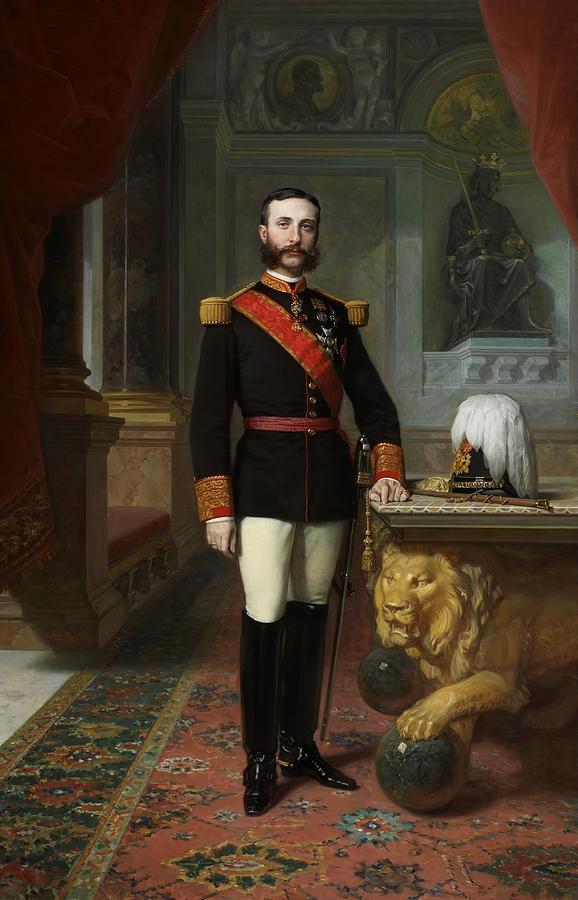
Alfonso XII
Artist: Federico De Madrazo y Kuntz (Spanish, 1815-1894)
Date: 1886
Medium: Oil on canvas
Collection: Museo del Prado, Madrid, Spain
Description
This is a posthumous portrait of the monarch. He appears standing, in full-length, and dressed in a simple captain-general's uniform, upon which he bears the grand laureate cross and sash of the military order of San Fernando (Saint Ferdinand), as well as the decorations of the Golden Fleece hanging from his collar and a cummerbund and a saber girdle around his waist. He poses inside a palatial hall, on a rich carpet, resting his hand on one of the splendid hard-stone tables kept in the Museo del Prado , on which we see the command baton and the feathered helmet of his uniform. In the shadows of the sumptuous architecture in the background, there is a niche with a statue of a medieval monarch – probably King Alfonso X the Wise, the immediate nominal predecessor of the monarch – and a medallion with the effigy of King Charles V.
Federico de Madrazo had already painted portraits of Alfonso XII on several occasions throughout the king's lifetime, according to the records in his inventory. However, this portrait was commissioned from the painter in 1886, the year following the king's death. It was intended for the Ministry of Public Works, which back then was home to the Contemporary Section of the Museo del Prado . It was immediately transferred to the Museum, probably with the purpose of being integrated within the Chronological Series of the Kings of Spain, a project initiated by José de Madrazo.
#portrait#oil on canvas#male#standing#full length#painting#spanish monarch#alfonso xii#captain uniform#military order of san fernando#palatial hall#hard stone table#statue#architecture#oil painting#posthumous#federico de madrazo y kuntz#spanish painter#spanish culture#spanish king#artwork#european art
31 notes
·
View notes
Text

On January 23rd, 1878 Alfonso XII married his first cousin, Mercedes of Orleans. Not long after the marriage, it became obvious that the young Queen was suffering from Typhoid. Five months after the wedding, having also said to have suffered a miscarriage, she succumbed to her illness just a few days after her 18th birthday.
26 notes
·
View notes
Text
Alleged last wishes of king Alfonso XII of Spain to his queen, Maria Christina of Austria-Tescgen, in his deathbed.

#“Keep your p*ssy at bay” said the man that didn’t keep in his pants for other women during their six years of marriage 😀#Alfonso XII#I hope this isn’t real but honestly I hardly wait anything good from this man#House of Bourbon#Wise counsel 🙃
2 notes
·
View notes
Text
Las dos vidas del crucero "Reina Mercedes"
La mañana del 19 de agosto de 1894 llegaba al puerto de Barcelona la Escuadra de Instrucción de la Armada española compuesta por los cruceros desprotegidos “Alfonso XII” y “Reina Mercedes”, procedían del puerto de Valencia y echaron el ancla junto a la escollera del este. La escuadra estaba al mando del contralmirante José María de las Heras con el crucero “Alfonso XII” como buque insignia(Museo…
#1894#1898#Alfonso XII#Armada Española#clase Reina Cristina#crucero#crucero de 1ª clase#crucero desprotegido#Guerra de Cuba#IX-25#Puerto de Barcelona#Reina Mercedes#USS Reina Mercedes
0 notes
Text
So beautiful 🥰
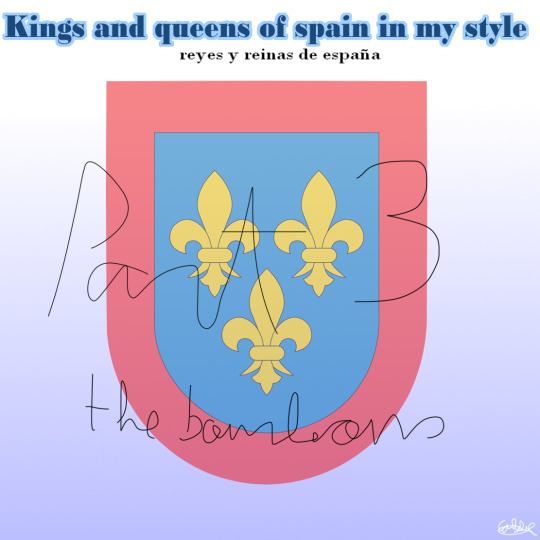
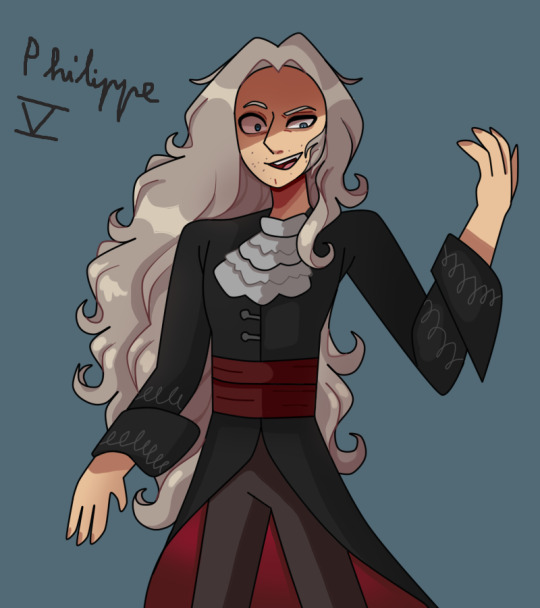

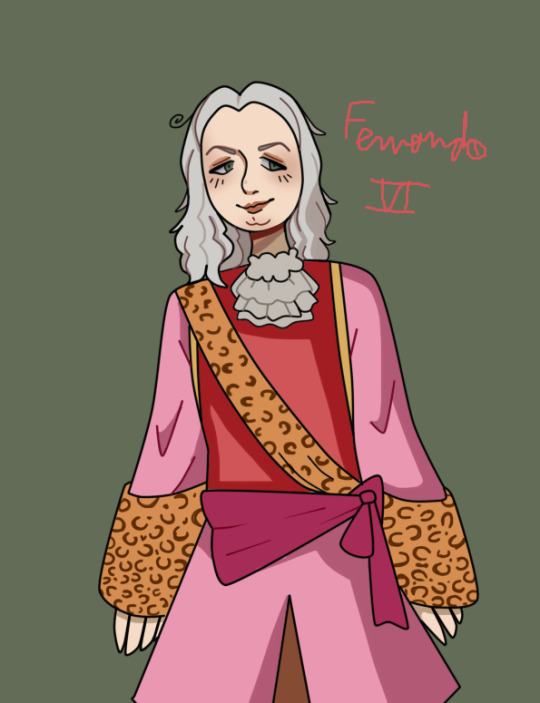
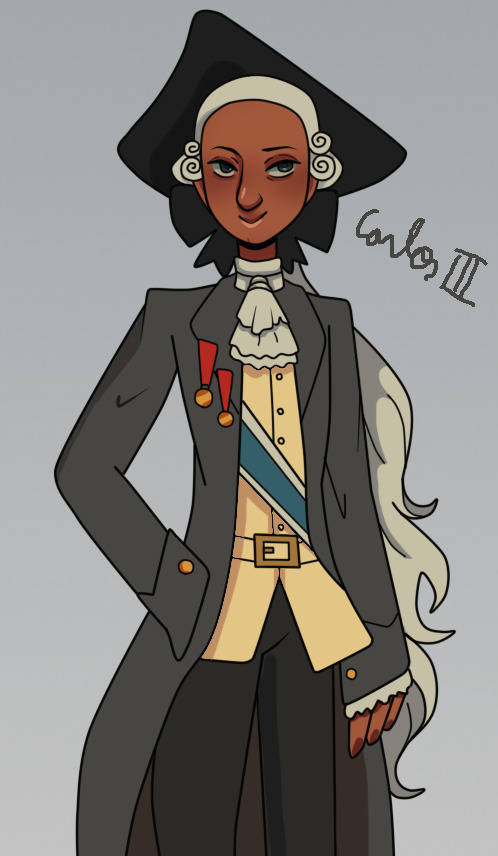



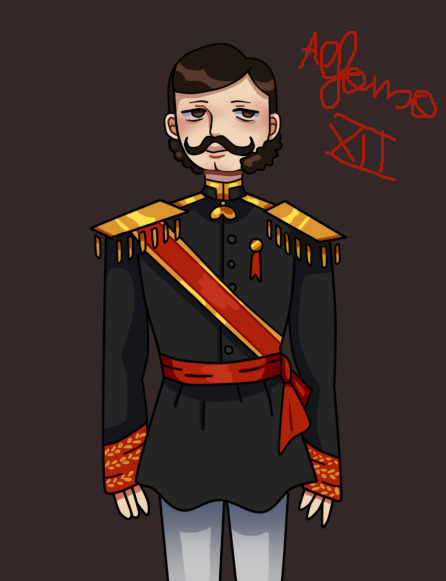
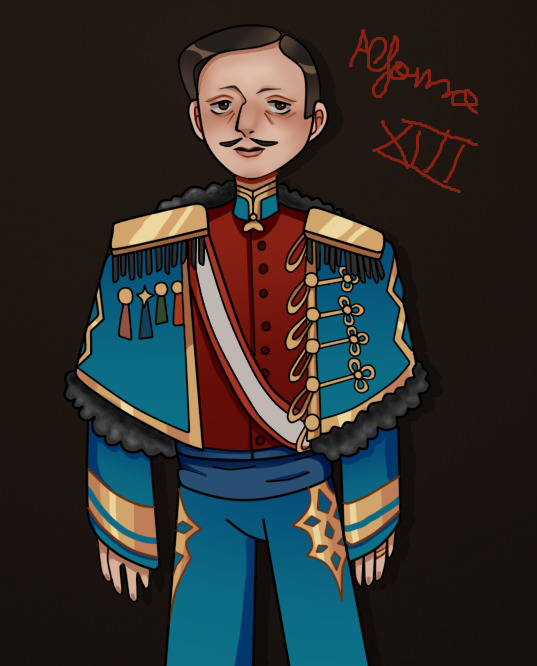
last part
#louis of spain#isabel ii#alfonso xii#louis i#alfonso xiii#carlos iii#spain#carlos iv#fernando vii#felipe v#fernando vi#felipev#bourbons
24 notes
·
View notes
Text
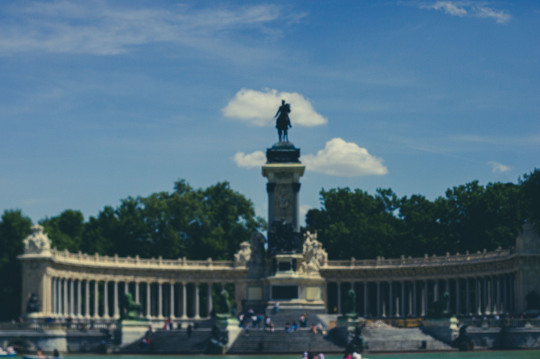
Sería coherente abrir un burdel a los pies del monumento a Alfonso XII. (Y trasladar el centro de salud especializado en ETS, frecuentado por las trabajadoras sexuales, que hay en la calle Sandoval).
#fotografía#photography#original photographers#street photography#paisaje urbano#photographers on tumblr#fotos tumblr#madrid#julian callejo#alfonso XII#reyes#puteros
0 notes
Text

Federico de Madrazo y Kuntz
Retrato del rey Alfonso XII (1886)
Palacio Real, Madrid
2 notes
·
View notes
Text
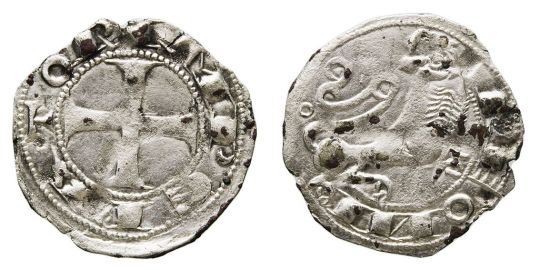
Óbolo de Alfonso VII de León ''el Emperador'' con la leyenda ''Imperator Leoni''
#numismática#arqueología#reino de león#alfonso vii#península ibérica#españa#moneda#alfonso vii de león#monedas#edad media#siglo xii#coin#numismatics#archaeology#coins#kingdom of león#iberian peninsula#spain#middle ages#12th century#medieval period
1 note
·
View note
Text
Pues aquí vamos.
La España del siglo XIX sufrió cinco epidemias de cólera morbo —aunque algunas fuentes solo consideran cuatro—, que abarcaron los siguientes años:
La primera, entre 1833-1834, que, a pesar del conocimiento que se tenía en el país del cólera y las medidas de contención aplicadas, logró penetrar en territorio nacional desde Portugal a Galicia y Andalucía. Al año siguiente afectaría a Castilla (ejem, ejem, guerras carlistas, ejem, ejem). Sería la de mayor número de muertos, con una cifra aproximada de 300.000 fallecidos; el doble que en los siguientes brotes,
La segunda, entre 1854-1856, que afectaría a las zonas del interior de la península, como Madrid.
La tercera, entre 1865-1866, se difundiría desde Valencia al resto del levante, aunque luego afectaría también a Barcelona, Zaragoza y Madrid. Contribuiría a una situación social que terminaría por desembocar en la Revolución Gloriosa, en 1868, con la expulsión de la reina Isabel II.
La cuarta, entre 1885-1886 (algunas fuentes marcan el origen del brote en 1884), sería una de las más virulentas, a pesar de que para ese momento se tenía gran conocimiento sobre el microorganismo que ocasionaba la enfermedad (Robert Koch había aislado al agente patógeno en 1883).
Y la quinta, entre 1890-1891, aunque, comparada con las anteriores, apenas fue significativa, junto a aquellas ocurridas a comienzos del siglo XX.
Debido a los graves efectos que tuvieron las tres última en la industria naciente del ferrocarril, he podido recuperar algunas de las instrucciones que se daban para intentar evitar la transmisión de la enfermedad en los últimos años.
Pocos antes del segundo brote, se publicaría la Real Orden e Instrucciones de Sanidad de 30 de marzo de 1849 en la Gaceta de Madrid, en la que se pueden destacar las medidas de limpieza, ventilación e higiene, el control sobre los alimentos de la policía sanitaria en los mercados y plazas, la fumigación con ácidos minerales y, principalmente gas de cloro —se habla del agua clorurada en riego, aspersiones y evaporación—, del procedimiento tras la muerte de un enfermo y de las instrucciones de las casas de socorro, hospitales y enfermerías coléricas, entre otras.
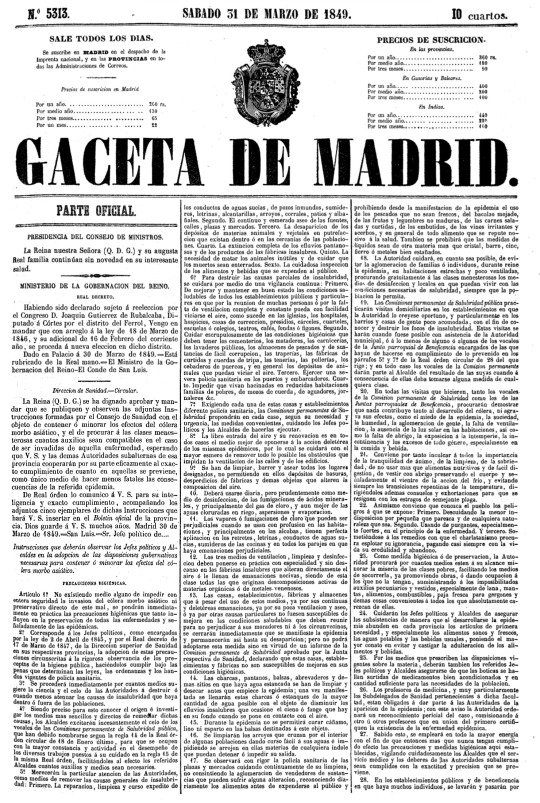
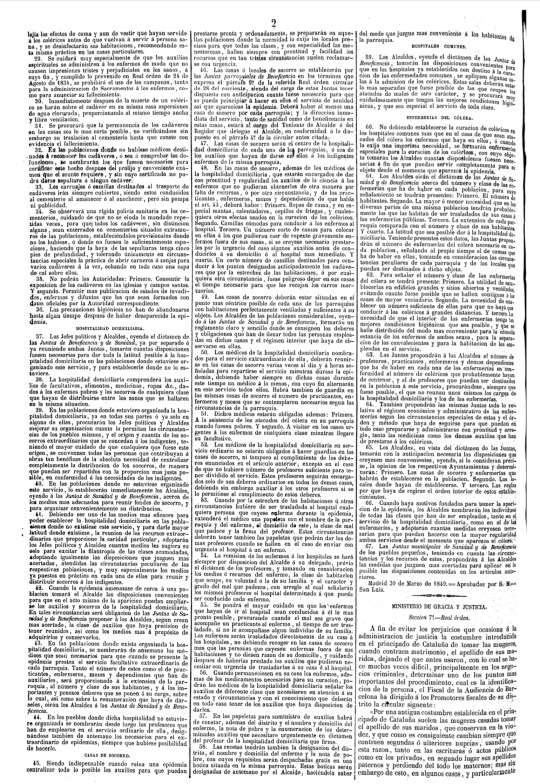
En un documento firmado por el Jefe del Servicio Sanitario de la Compañía de los Caminos de Hierro del Norte de España, Estaban Sánchez de Ocaña, con fecha de 13 de junio de 1885, se empieza explicando qué es la enfermedad del cólera-morbo-asiático, sus síntomas y las causas que lo provocan.
Entre estas, enumera la suciedad, la falta de ventilación, los excesos en las bebidas y comidas, la falta de limpieza en retretes, el uso de aguas contaminadas y la falta de precaución en el tratamiento y desinfección de las ropas y enseres de los coléricos.
A continuación, afirma que, con tal de garantizar un adecuado tratamiento y prevención del cólera, la única medida posible es garantizar el cumplimiento de los preceptos y consejos higiénicos dados en cuanto a las habitaciones, alimentos, bebidas, ropas y vestidos, limpieza personal y primeros auxilios y precauciones a adoptar con los enfermos.
A pesar de que no he podido acceder como tal al anterior, un documento de la Compañía de los Ferrocarriles de Madrid a Zaragoza y a Alicante, más concretamente en la Red Catalana, a fecha de 7 de septiembre de 1911, recoge la siguiente descripción:
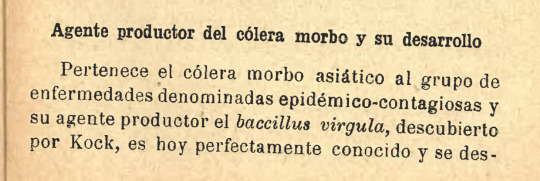
*Bacillus virgula fue el nombre original del patógeno que le puso Koch, aunque se terminaría cambiando a Vibrio cholerae.
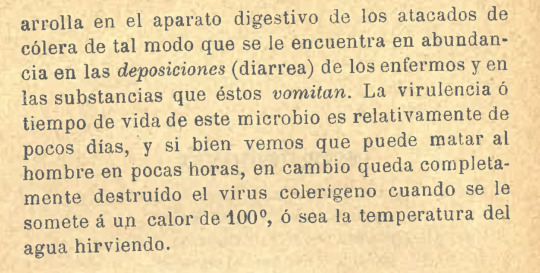
A continuación, pasaba a describir el modo de transmisión y métodos para su prevención, sobre todo a las personas que se dedicaban al cuidado del enfermo.
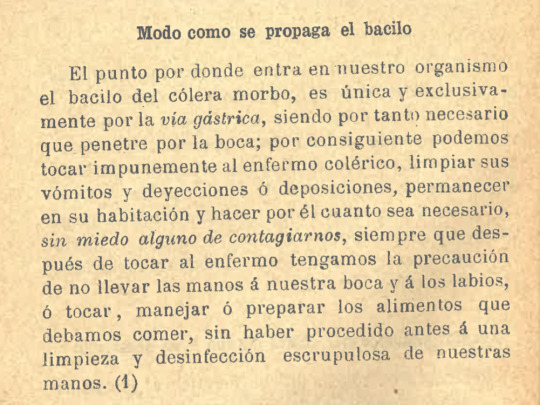
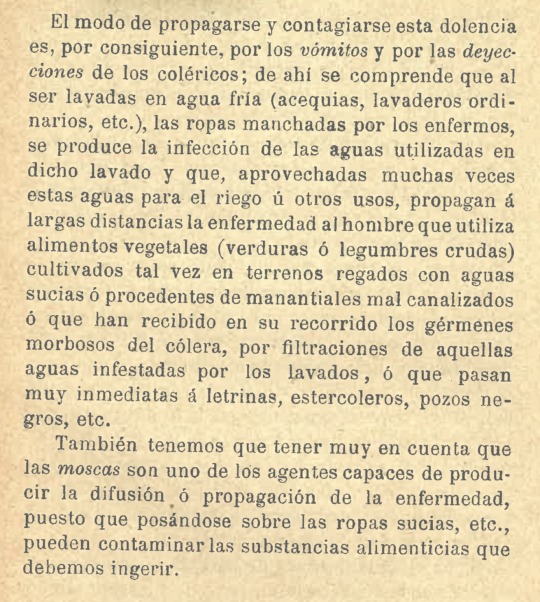
El mayor cuidado se debía tener con las fuentes de agua, que se debía hervir o filtrar de forma adecuada, y con los alimentos como ensaladas, verduras y frutas que no se pudiesen someter a la cocción.
Se partía del convencimiento —como se ha podido leer con anterioridad—, de que la temperatura de ebullición del agua, de 100º, era capaz de eliminar al patógeno por complejo.
Afortunadamente, en la actualidad se sabe que no producen esporas, una especie de forma de resistencia que algunas bacterias crean en condiciones desfavorables para que la colonia se vuelva a desarrollar en condiciones favorable, por lo que la esterilización era eficaz.
Posteriormente, daba detalles sobre cómo tratar el agua.
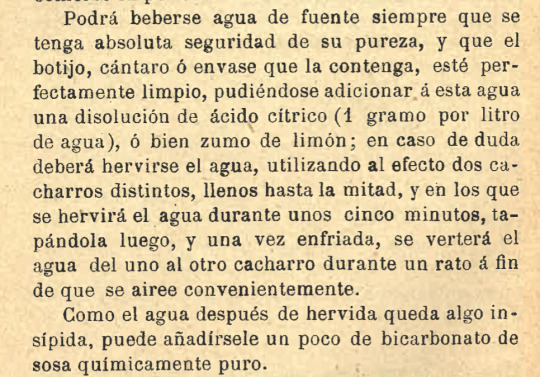
Se recomendaba, además, evitar las bebidas de extraña procedencia y las alcohólicas.
Aquellos con desarreglos digestivos se encontraban mucho más vulnerables a la infección, y, de hecho, en otro documento, publicado un año antes, en 1910, por la misma Compañía MZA, firmado por el director general R. Coderch y el doctor E. Varela, se detallaban las siguientes instrucciones, entres las que destacaba la de evitar las frutas verdes o pasadas.

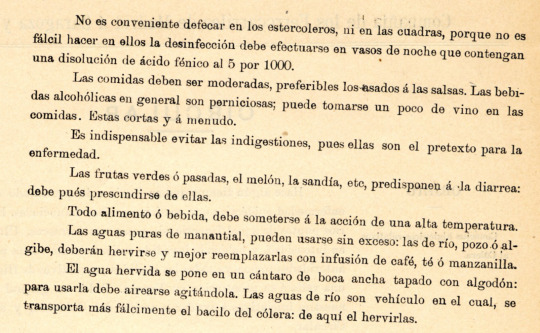
Volviendo al documento del 7 de septiembre de 1911 que se estaba tratando anteriormente, añadía el consejo de evitar también los tomates y pimientos, incluso aunque estuviesen cocidos, y evitar el consumo de bebidas my frías.
También había que tener cuidado con la alimentación de los niños de corta edad, destacando aquellos en la dentición, debido a su predisposición a «desarreglos de vientre». Y evitar que el estómago y el vientre estuviesen expuestos al frío, especialmente después de las comidas.
El agua del mar, por supuesto, ni tocarla y más si estaba próxima a la desembocadura del alcantarillado, y había que tener especial cuidado si se decidía bañarse de no tragarla sin querer.
La limpieza de manos era esencial cuando se quería llevar cualquier cosa a la boca (incluso en la acción de liar un cigarrillo), y más cuando se había tenido en casa a un enfermo con cualquier síntoma intestinal, fuese o no cólera.


Continuaba con un párrafo en el que se describían los primeros síntomas del cólera, además de su evolución.


Para unos primeros auxilios antes de la llegada de un profesional, se adjuntaban las siguientes instrucciones.
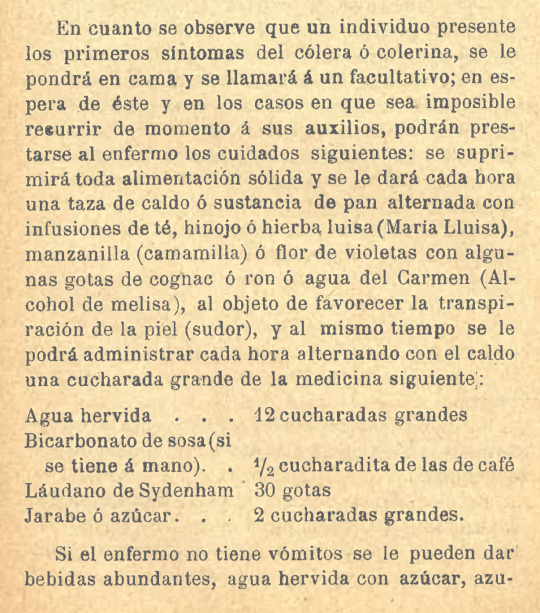
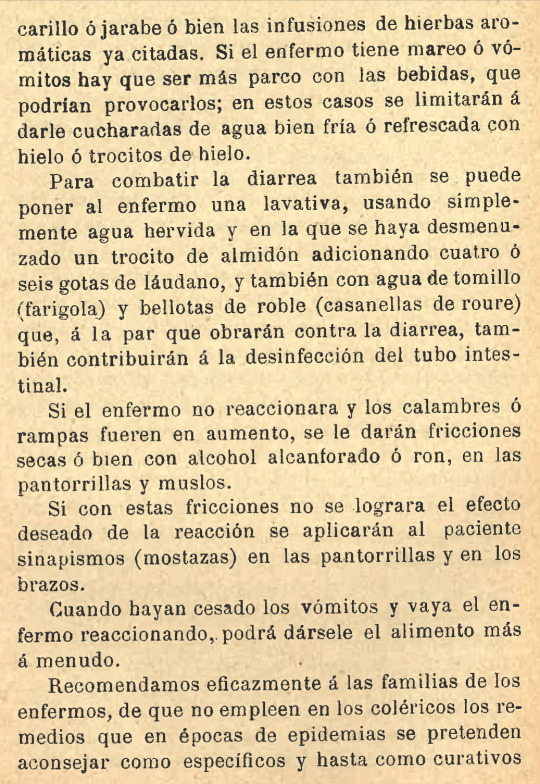

El documento terminaba con las medidas de desinfección que se debían tomar en una casa en la que había un enfermo de cólera, remarcando la importancia de la limpieza y la ventilación.
También daba instrucciones sobre cómo realizar la fumigación, resaltando la importancia que tuvo esta estrategia en el cuarto brote de la enfermedad.
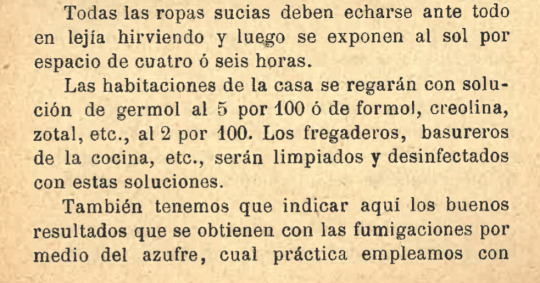
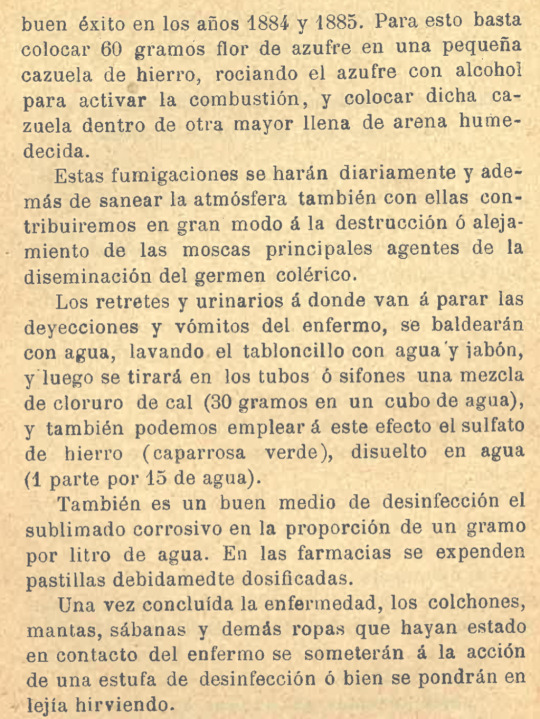
El suministro de medicamentos, sobre todo de los más urgentes, quedaba a disposición del Servicio Sanitario y los botiquines de todas las estaciones.
Estas instrucciones tan detalladas, como se ha podido ver, son muy posteriores a los cinco brotes del cólera, pero servirían para evitar epidemias tan severas como las que se habían vivido en el siglo anterior.
El cólera dejó muchas enseñanzas en cuanto salud pública y, también, algunas anécdotas, como es la visita de Alfonso XII a los enfermos del cólera en Aranjuez.
Y es que, el día 2 de julio de 1885, el Rey, que en esos momentos contaba con 27 años, salió sin avisar a nadie —salvo a su ayudante, que lo acompañaba—, hacia la estación de tren, desde donde viajaría a Aranjuez, arrasada por los efectos de la enfermedad. En la estación, por supuesto, lo reconocería el jefe de servicio, que le ofrecería viajar en un coche salón.
Alfonso lo rechazaría.
En Aranjuez, recorrería el hospital del Real Patrimonio y dos hospitales habilitados, uno en Casa de los Marinos y otro en un colegio. Repartió hasta 60.000 reales en limosnas, y todos los presentes pudieron ser testigos de cómo el monarca se aproximaba a las camas de los enfermos y les hablaba a modo de consuelo.
Incluso mantendría una conversación con un soldado natural de Murcia, lugar en el que el cólera también estaba presente —de hecho, se dice que el brote en Aranjuez se originó por un jornalero huido de Murcia—, en el que le diría que, si no había ido allí, era porque no había podido, pero que supiesen todos los españoles que él les acompañaba en sus aflicciones y en su desventura.
Al regresar el monarca a Atocha, todo el pueblo de Madrid sería testigo de una escena inédita; la reina, María Cristina, se tiró a abrazar al Rey recién bajado del tren, y ambos serían fumigados.
En todos los periódicos se leían titulares sobre que el Rey había desafiado al cólera. Sin embargo, ninguno sabía que Alfonso XII ya estaba enfermo de tuberculosis para aquellos momentos, su causa de fallecimiento el 25 de noviembre de ese mismo año, sin permitirle siquiera haber cumplido los 28.
Pero eso es otra historia.
En la actualidad, se sabe que el cólera es una enfermedad causada por el patógeno Vibrio cholerae, o, más concretamente, por la toxina que producen algunas de sus cepas.
A nivel molecular, esta toxina ocasiona la acción constante de un canal que expulsa iones cloruro de las células intestinales —el mismo canal cuyo defecto por causas genéticas desemboca en la fibrosis quística—, lo que produce también una salida de agua (básicamente, esta siempre se dirige a donde mayor concentración de iones haya para diluir) que termina por desembocar en una deshidratación extrema.
Como tratamiento, ahora se utilizan bebidas que incluyen en su composición agua, azúcar (glucosa) y sales minerales (sodio); estas dos últimas esenciales para la captación de agua en las células intestinales por mecanismos moleculares, además de antibióticos, que se especializan en atacar al patógeno y no a todas las células del huésped (como hacían los medicamentos de los que hablaban las guías a inicios del siglo XX).
Sin embargo, las infusiones, el agua hervida con azúcar y demás bebidas descritas en el documento adjuntado con anterioridad eran la principal clave para la lucha contra la enfermedad, puesto que rehidrataban el organismo del enfermo y evitaban el agravamiento de los síntomas y, por tanto, la muerte, para que el cuerpo pudiese, por sus propios medios, eliminar la toxina y sus efectos nocivos. De hecho, en 1911 ya se estaba hablando de «una vez pasada la enfermedad...».
Y ya está.
.
Glosario de enfermedades (detalles generales del cólera).
Hay una cierta parte de mi persona que me pide no dejar de lado las epidemias de cólera, y más en España.
Yo solo aviso.
3 notes
·
View notes
Text
Los Sorolla de Cuba: “El niño de la sandía”.
“El niño de la sandía”, fue la primera obra de Sorolla, que ingresó a la colección del Museo Nacional de Bellas de Artes de Cuba. Con el objetivo de comprar pintura para sus fondos, en el año 1920, el entonces director de la institución, Antonio Rodríguez Morey, viajó a Madrid. Pintor él mismo y conocedor del maestro valenciano, acudió a su taller, donde adquirió la pieza por el bajo precio de 4…

View On WordPress
#Antonio Rodríguez Morey#Gran Cruz de la Orden Civil de Alfonso XII#Joaquín Sorolla Bastida#Manuel Crespo Larrazábal#Museo Nacional de Bellas de Artes de Cuba
0 notes
Text
Well, it was bound to happen:
A collection of medieval and medieval-inspired music that fits the vibe of Cadfael's world! Some love songs, some crusade songs, some hymns, some songs about nature and the turn of the year, and some instrumentals.
I've made an effort to include 12th century music, but many of these are 13th century. A few are 14th, and a few are modern.
(Fun fact: Chanterai por mon corage, which dates from the second crusade, is mentioned, albeit not by title and with some details changed, in Monk's-Hood.)
Ca 1h 40 minutes, for now. Will no doubt be updated/changed and added to as I find more music.
Floruits/lifespans and approximate datings under the cut:
Walther von der Vogelweide: c. 1170-1230 Richard I of England: 1157-1199 Raimon de Miraval: c. 1135/1160-1220 Guiot de Dijon: fl. 1215-25 Blondel de Nesle: c. 1155-1210, or d. 1241 Giraut de Bornelh: c. 1138-1215 Bernart de Ventadorn: c. 1130-1200 Hildegard von Bingen: c. 1098-1179 Alfonso X of Castile: 1221-1284 Peter Abelard: c. 1079-1142
Blow Northerne Wynd: c. late 13th/early 14th cent Nou Shrinketh Rose: c. late 13th/early 14th cent Mirie it is: c. early 13th cent Lyke Wake Dirge: attested 17th cent, but is much older Dance of the forest of no return/Stantipe II: Chansonnier du Roi, c. 1300 Bujo: Anonymous, c. 13th cent Flos in monte cernitur: Florence Manuscript, c. 1245-55 Beata nobis gaudia: Manuscripts Jul. A. vi, Vesp. D. xii, both 11th cent. Redit aetas aurea: coronation of Richard I of England All the Cantigas date to the reign of Alfonso X.
106 notes
·
View notes
Text

Alfonso XII
Artist: Manuel Domínguez Sánchez (Spanish, 1840-1906)
Date: c. 1875
Medium: Oil on canvas
Collection: Museo Nacional del Prado, Madrid, Spain
Alfonso XII
Alfonso XII (Alfonso Francisco de Asís Fernando Pío Juan María de la Concepción Gregorio Pelayo de Borbón y Borbón; 28 November 1857 – 25 November 1885), also known as El Pacificador (Spanish: the Peacemaker), was King of Spain from 29 December 1874 to his death in 1885.
After the Glorious Revolution of 1868 deposed his mother Isabella II from the throne, Alfonso studied in Austria and France. His mother abdicated in his favour in 1870, and he returned to Spain as king in 1874 following a military coup against the First Spanish Republic. Alfonso died aged 27 in 1885, leaving his pregnant widow, Maria Christina of Austria, as regent of Spain. Their son, Alfonso XIII, became king upon his birth the following year. Maria Christina continued as regent until Alfonso XIII came of age in 1902.
#portrait#full length#painting#alfonso xii#king of spain#spanish monarchy#spanish royal family#oil on canvas#fine art#artwork#oil painting#spanish culture#spanish king#costume#table#chair#manuel dominguez sanchez#spanish painter#european art#19th century painting#spanish history#museo nacional del prado
13 notes
·
View notes
Text
Anarchist events in March
March 1st & 2nd
Anarchism Across the Arts Conference (Canada)
Paul Philips Hall (1923 Fernwood Road)
Victoria, BC, Canada
19th Annual 2.Dh5 Festival (Netherlands)
March 1st & 2nd
14th Sevilla Anarchist Bookfair (Spain)
March 13th-16th
CGT Sevilla (C/ Alfonso XII, 26)
5th Mexico City Anarchist Publication & DIY Fair (Mexico)
March 22nd
Guie'Huini (Magnolia 148, Guerrero, Cuauhtémoc)
Mexico City, Mexico
March 27th & 28th
Vancouver Anarchist Bookfair
AMS Nest at UBC (6133 University Blvd.)
RAFALES: An anarchist learning camp (Canada)
March 28th, 29th & 30th
At Comité Social Centre-Sud (1710 Beaudry St.)
Montreal, Canada
https://ora-rao.org/rafales-eng/
38 notes
·
View notes
Text
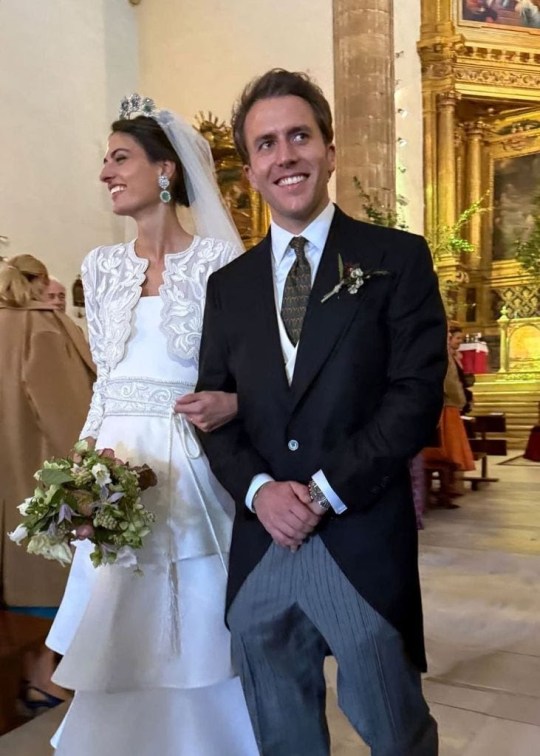





Madrid, 22.03.2025
Prince Cecil von Croÿ, son of Prince Nikolaus von Croÿ, Graf of Schmettau and Countess Maria Wolff Metternich zu Gracht, married Victoria Matossián y Márquez, the daughter of Doña Sonia Márquez y de Baviera and Don Miguel Matossian y Osorio, at the Church of San Pedro Apóstol in Fuente el Saz de Jarama outside Madrid, followed by a Reception at the Soto Mozanaque Estate in Algete, owned by the Duke of Alburquerque.
Victoria Matossián is great-grandaughter of Infante José Eugenio de Baviera y de Borbón, grandson of King Alfonso XII and Queen Maria Christina of Spain, a member of the Spanish branch of the Bavarian royal family. The bride wore an Emerald Flowers Tiara of Queen Isabella II of Spain (1830-1904).
Source: Instagram
28 notes
·
View notes
Text


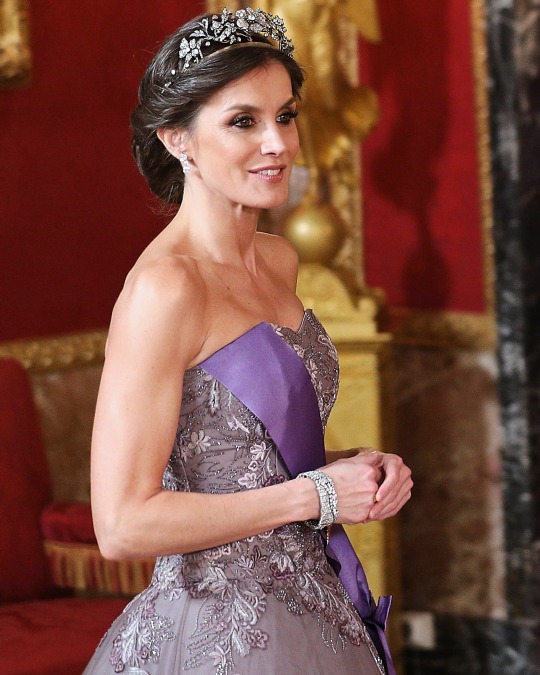
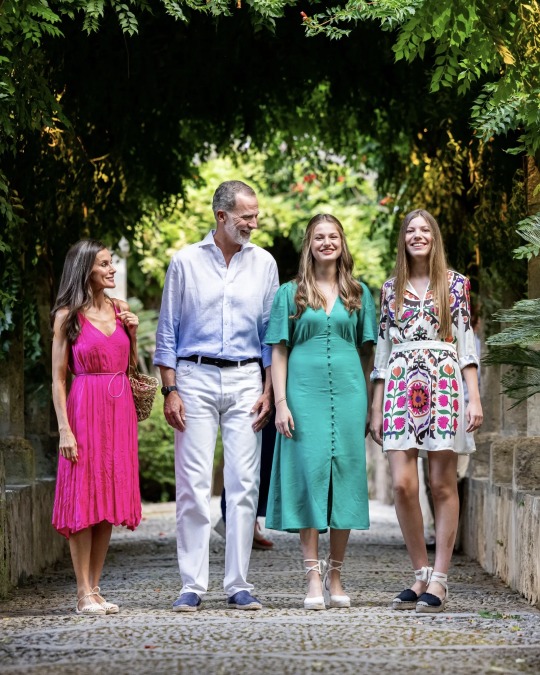
Happy 52nd birthday to Queen Letizia of Spain!
Born 15 September 1972, Letizia Ortiz Rocasolano is Queen of Spain as the wife of King Felipe VI.
Letizia was born in Oviedo, Asturias. She completed a bachelor's degree in journalism, at the Complutense University of Madrid, as well as a master's degree in audiovisual journalism at the Institute for Studies in Audiovisual Journalism. She worked as a journalist for ABC and EFE before becoming a news anchor at CNN+ and Televisión Española.
In August 2003, a few months before her engagement to Felipe, Prince of Asturias, Letizia was promoted to anchor of the TVE daily evening news programme Telediario 2, the most viewed newscast in Spain. In 2000, she reported from Washington, D.C., on the presidential elections. In September 2001, she broadcast live from Ground Zero following the 9/11 attacks in New York and in 2003, she filed reports from Iraq following the war.
On 1 November 2003, the Royal Household announced Letizia’s engagement to Prince Felipe. The wedding took place on 22 May 2004 in the Almudena Cathedral in Madrid. Letizia and Felipe have two daughters: Leonor, Princess of Asturias (18) and Infanta Sofía (17).
On 19 June 2014, Letizia became Queen of Spain with her husband's accession as Felipe VI. She is the first Spanish-born queen consort since Mercedes of Orléans, the first wife of Alfonso XII, in 1878. She is also the first Spanish queen to have been born as a commoner.
35 notes
·
View notes
Text
El Legado del Doctor Velasco
Cada día, al pasar por la Cuesta de Moyano, me encuentro un edificio de gran belleza arquitectónica, testigo de una historia tan fascinante como inquietante. Hoy alberga el Museo Nacional de Antropología, obra del arquitecto Marqués de Cubas, pero en el siglo XIX fue la residencia del doctor Pedro González Velasco, un célebre médico segoviano cuya vida terminó envuelta en leyenda.
Tras la muerte de sus padres, Velasco se trasladó a Madrid, donde se dedicó al estudio del cuerpo humano. Su pasión por la anatomía lo llevó a diseccionar cientos de cadáveres y a reunir una extensa serie de utensilios médicos, objetos etnográficos y curiosidades recogidas durante sus viajes por el mundo. Gracias a su prestigio, mandó construir esta majestuosa mansión con el propósito de exhibir su colección, que con el tiempo daría origen al museo actual.
Pero en 1864, su vida dio un giro trágico: su única hija, Conchita, falleció a los quince años, víctima de la fiebre tifoidea, una enfermedad infecciosa transmitida por alimentos contaminados. Incapaz de aceptar su pérdida, Velasco cayó en una obsesión que marcaría para siempre su vida. Solicitó permiso legal para embalsamar su cuerpo y, tras un largo proceso, lo exhumó. Se cuenta que logró conservarlo con tal perfección que los miembros permanecieron flexibles. La vistió con ropas de la época, la maquilló con esmero y colocó el cuerpo en una urna dentro de la capilla de su museo. Desde entonces, convivió con sus restos como si aún estuviera viva. Los rumores se mezclaron con la realidad y contribuyeron a la fábula de un hombre atormentado, al borde de la enajenación.
Con el paso de los años, su salud se deterioró, tanto física como mentalmente. Murió en 1882. Aunque su deseo era ser enterrado junto a su hija en la capilla del museo, parece que su viuda, Engracia Pérez, trasladó los restos de Conchita al panteón familiar en la Sacramental de San Isidro, donde hoy descansan los tres.
La historia invita a reflexionar sobre la compleja relación entre la medicina y la bioética, y cuestiona hasta qué punto el dolor puede llevar al ser humano hacia la locura. Nos recuerda, además, que la ciencia, por valiosa que sea, no está exenta de límites morales.

El Museo Nacional de Antropología está situado en la esquina del Paseo de la Infanta Isabel con la calle de Alfonso XII, muy cerca del Parque del Retiro y de la estación de Atocha de Madrid.
14 notes
·
View notes